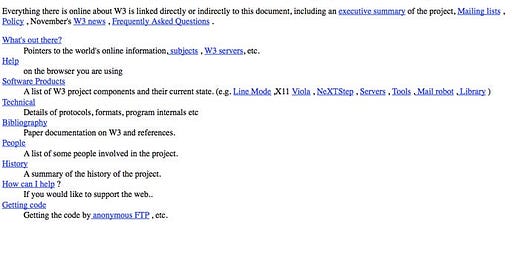How we became the hosts of the web
Analysis of how the shift from the logic of a "homepage" to a "home screen" imposes a new relationship with the web.
The first web page - and consequently the first homepage in the history of the web - was launched on August 6, 1991. It was a page dedicated to information access, created by Tim Berners-Lee from a computer at CERN, which, by the way, had the brilliant idea of simulating it on their website.
The experience was straightforward: a series of links allowed users to navigate from one page to another. The translation of "home page" into French is interesting; the term "page d'accueil" refers more to the semantics of libraries, places, and institutions, rather than a comfortable home. It's a welcoming place where you are directed to the right location.
Editorialization and Capitalization
Soon, this rather cold and disinterested logic was challenged by the first web browsers. The evolution of Netscape is interesting: from its early versions in 1994, the company offered a form of editorialization and curation of web resources through its own perspectives, with buttons like "what's new" or "what's hot." Links were never neutral.
The war for people's attention (and clicks) can be viewed through the lens of the battle between search engines, which were the entry points for web experiences for years. Yahoo! quickly envisioned itself as a "portal," with its famous site directories and the latest news. This was a kiosk of services in addition to a giant index that once again relied on people's capacity and desire to navigate from link to link. Meanwhile, Google's promise was clear: to organize the world's information, make it universally accessible and useful. The updated 2023 version of the search engine's mission is crucial to understanding the stakes:
"Users around the world rely on our search engine to find information, learn about topics that interest them, or make important decisions. We know they count on us, and our commitment remains steadfast. As technology evolves, we continue to help each user get the information they're looking for." - Google
Helping make important decisions: the revolution is in these few words. Google's homepage—or more precisely, the home screen click on smartphones—aims to be a companion for users' immediate needs and desires. Google promises not only to respond to explicit demands but also to work on latent human demands. This is evident every day with the multiple suggestions that Google offers, from creating collages with stored photos to calls for contributions on Google Maps.
From the home page to the home screen: Emotion vs. Library Logic
The homepage can no longer be thought of in isolation from the rest of the user experience. On our smartphones, notifications lead users to check what's happening and enter specific applications much more aggressively. In other words, we are no longer going to the entrance of a library to find a resource; we have become the hosts of a home or reception for a series of solicitations, both private and commercial or professional. Social networks turn our available seconds into real pressure to make the right choices. Ultimately, the act of searching has become a minority compared to the hundreds of other tacitly imposed actions, whereas at the beginning of the web, searching was the point of entry.
In this new normal, it's not surprising that TikTok becomes an alternative to search practices. Serving as both entertainment and a constant flow of information, signals, and a place for socializing in front of a smartphone—and beyond ("Did you see the latest TikTok?")—the platform offers an intuitive, easy-to-use solution on highly competitive and optimized formats designed to capture our attention. While watching the 8 p.m. news on TF1 or France 2, I even struggled to find a topic that didn't mention the influence of TikTok.
We have become the hosts and hostesses of the web. The risk is that we may be subjected to a distant, fictional media agenda. People's digital environment, under the guise of personalization, is filled with app logos, creating a feeling of liveliness, truth, and tangibility as we smoothly swipe through touchscreens. Paradoxically, due to habits and the assistance in our content consumption, we lose in effort what we gained in developing our critical thinking.





